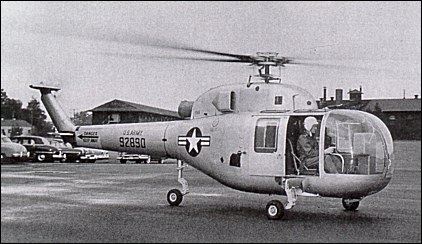
| Sikorsky S-59 / XH-39 1971 |  |
 |

| Sikorsky S-59 / XH-39 1971 |  |
 |
|
Around 1955, the two-blade Bell rotor scored a brilliant victory over the four-blade Sikorsky. In fact, the Model XH-39 (S-59), using a 400shp Continental XT51 turbine, was rejected by the US Army, despite its speed and the advantage of retractable landing gear, as being old-fashioned in design and unsuitable for further development. Instead, the Army chose the Bell XH-40 with a Lycoming XT53 turbine. Nevertheless the four-seat XH-39, with retractable tailwheel landing gear and a new four-blade rotor, broke the world speed record over 3km in 1954 by flying at 251km/h. The ill-fated Sikorsky aircraft had been built using a modified YH-18A airframe, itself derived from the unsuccessful postwar S-52. G.Apostolo "The Illustrated Encyclopedia of Helicopters", 1984
In late 1953 the Army awarded Sikorsky a contract for the experimental conversion of two existing H-18 helicopters from piston to turbine power. The two aircraft selected for conversion were 49-2890 and -2891, the third and fourth H-18s built, with the former to be used for flight testing and the latter for static engineering evaluation. Sikorsky allotted the two craft the company designation S-59, and began the conversion work in early 1954. The H-39 retained the H-18's basic pod-and-boom layout, but differed from the earlier machine in several significant ways. The most obvious difference was, of course, in powerplant. The H-39 was powered by a single 400shp XT51-T-3 Artouste II turbine engine, which drove a new, fully-articulated, four-bladed main rotor. Other changes included a modified tail rotor, strengthening of the fuselage, incorporation of retractable wheeled landing gear, and the addition of updated electronics. The H-39 was the Army's first turbine-powered helicopter, and was for a time the world's fastest rotorcraft. On 26 August 1954 Army Warrant Officer Billy Wester flew the craft to a new world helicopter speed record of 251kph; less than two months later Wester and his H-39 set a new world helicopter altitude record by reaching 7474m. The H-39 provided the Army with much valuable information on the capabilities of turbine-powered helicopters, and the success of its three-year evaluation was instrumental in bringing Army aviation into the turbine age. S.Harding "U.S.Army Aircraft since 1947", 1990
|